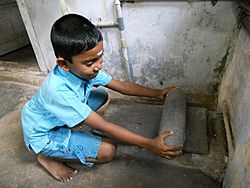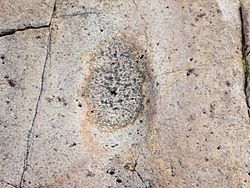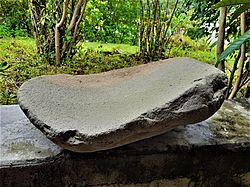Metate facts for kids

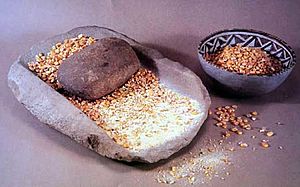
A metate is a special kind of stone tool used for grinding grains and seeds. Think of it like an ancient blender! In old Mesoamerican cultures, women often used metates to grind maize (corn) that had been treated with lime. This was a key step in making foods like tortillas. You can find similar grinding stones all over the world, even in places like China.
Contents
What is a Metate and How is it Used?
Metates are usually large, heavy stones with a smooth dip or bowl carved into the top. To grind things, you use a smaller, hand-held stone called a mano. You rub the mano back and forth or in circles on the metate. This is different from a mortar and pestle, which uses an up-and-down crushing motion.
The shape of the metate helps turn grains into flour. Some metates are flat, some are slightly curved like a bowl, and others have a deeper groove called a trough. The deeper the bowl, the more it was used!
Sometimes, you can find natural grinding spots on large rocks or bedrock outcroppings. These are like natural metates, used for grinding things like acorns. Over time, these spots become smooth and might even have small dents.
When Were Metates First Used?
People started using metates a very long time ago. In Mexico, they were first used around 5000 BC to 3000 BC. In the American Southwest, they appeared around 3500 BC. The earliest ones were flat or bowl-shaped. The ones with a trough (a deeper groove) came later, around AD 450 in the Southwest.
Even today, metates are still used in some places. For example, in parts of rural Mexico, women still use them to grind corn for tortillas, just like their ancestors did.
Special Metates from Costa Rica
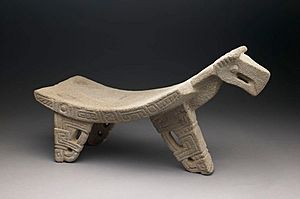
In Costa Rica, ancient people made amazing ceremonial metates from volcanic rock. These weren't just for grinding food! They came in many shapes: rectangular, circular, flat, or curved. Some had three or four legs.
Many of these special metates were found in burial sites. Some show signs of being used, but others look like they were made just to be placed in graves. This suggests they had a deeper meaning than just a kitchen tool. Some might even have been used as special seats or thrones!
Many ceremonial metates look like animals. They might have an animal's head at one end, with the metate itself forming the animal's body. Common animals include jaguars, crocodiles, and birds.
The most amazing type is called a "flying-panel" metate. These come from the Atlantic watershed region of Costa Rica. They are carved from a single piece of stone and often have many figures carved underneath the plate and on the legs. You might see images of birds, jaguars, monkeys, or saurian (lizard-like) creatures. These "flying-panel" metates are thought to be early forms of freestanding sculptures.
Meanings of Ceremonial Metates
The earliest stone sculptures in Costa Rica, including ceremonial metates, started around AD 1–500. Metates from different regions had different styles. For example, those from the Nicoya/Guanacaste region were curved and didn't have rims, while those from the Atlantic Watershed were flat with rims. Both types were found with burials, showing they were important for people's social status.
Later, around AD 1000–1500, new forms of ceremonial metates appeared. Some were rectangular with four legs, like the jaguar-headed ones. Others were round with a base and sometimes had carved human heads around the rim. These might have been linked to rituals involving trophy heads.
At an ancient site called Las Huacas, many metates were found in graves, but none had their grinding stones (manos) with them. This suggests these carved metates had a special symbolic meaning beyond just grinding food. The act of grinding corn into flour can symbolize life, death, and rebirth. It's even possible that corn was used to make a special drink called chicha (beer) for important ceremonies, rather than just for daily food. Their presence in graves shows metates were deeply connected to ideas about human life, death, and the hope for a new beginning.
Animal Symbols on Metates
The most common animals seen on ceremonial metates are saurian (like crocodiles or alligators), birds, and jaguars. Monkeys are also popular. Interestingly, human figures are rare on these metates, though some "flying-panel" metates have human-like figures with animal heads, often crocodile heads.
Saurian images are very common. People believe the saurian represents the surface of the earth, which connects to farming and making the land fertile. There's an old symbol called the Crocodile god, often shown as a human-like figure with a crocodile head. He appears on "flying-panel" metates, sometimes standing on a two-headed saurian or a jaguar. The two-headed saurian symbol was used for a very long time in this region.
Birds with long, curved beaks, like vultures, toucans, or hummingbirds, are another popular symbol. These birds are often shown on "flying-panel" metates, sometimes pecking at human heads.
Where to See Metates Today?
The largest collection of metates can be found at the National Museum of Costa Rica. You can also see over 20 metates at the British Museum.
Gallery
-
A metate being used in India.
-
An ancient bedrock metate at Huerfano Butte, Arizona.
-
Isabel Nicolás, a Ñuu Savi (Mixtec) woman, grinding corn dough on a yooso (metate in Mixtec) to make tortillas in San Juan Achiutla, Oaxaca, México, 2020.
-
A modern indigenous kitchen with a metate in front, a comal, a palm tenate, a molcajete (stone mortar), and a clay pot in San Juan Achiutla, Oaxaca, México, 2020.
-
A pre-Columbian Mixtec metate from San Juan Achiutla, Oaxaca, México, 2020.
See also
 In Spanish: Metate para niños
In Spanish: Metate para niños



